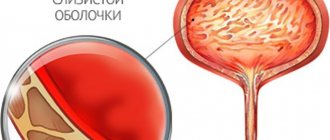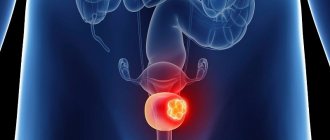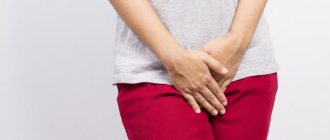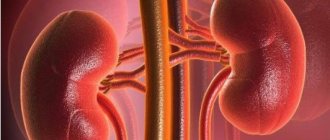The organs of the urinary system are often susceptible to various types of pathological diseases
. The causes of such diseases are completely different and begin from banal hypothermia and end with malignant formations. It is important to remember that untimely diagnosis and treatment of diseases can lead to serious consequences or the disease becoming chronic. The following are the main bladder diseases.
Cost of consultation?
| Name of service | Price, rub.) |
| Primary appointment with a urologist-andrologist | 2000 rub. |
| Repeated appointment with a urologist-andrologist | 1500 rub. |
| Primary appointment with an obstetrician-gynecologist | 2000 rub. |
| Repeated appointment with the obstetrician-gynecologist | 1500 rub. |
| Primary appointment with an obstetrician-gynecologist (candidate of medical sciences; doctor of medical sciences) | 2100 rub. |
| Repeated appointment with an obstetrician-gynecologist (candidate of medical sciences; doctor of medical sciences) | 1600 rub. |
| Prescription of treatment (drawing up an individual treatment regimen) | 1500 - 3000 rub. |
All our services and prices
Diagnosis of diseases
Diagnosis of bladder diseases begins with a survey and examination by a doctor. The patient needs to be told in detail about the symptoms, circumstances of occurrence and stages of development of the disease, medications taken, and treatment performed. If you have the results of past examinations on hand, you need to take them with you to your appointment.
To confirm the diagnosis, the doctor may prescribe additional examinations [6]:
- three-glass sample. With its help, you can identify the source of blood and pus in the urine. The patient urinates successively in 3 containers during one urination. If the bladder turns out to be a source of blood, then it will appear in the last (3rd) portion of urine, if the source of pus is the source, the urine will be cloudy in all three glasses [6].
- laboratory: general urine analysis, cytological, biochemical examination of urine, according to Nechiporenko, general clinical and biochemical blood analysis, determination of tumor markers in blood and urine;
- Ultrasound;
- MRI and CT;
- X-ray diagnostics with contrast (excretory cystography);
- urethrocystoscopy - the doctor examines the bladder using a cystoscope and can immediately pinch off a piece of suspiciously altered mucosa for histological examination.
Other bladder diseases
Bladder diseases in men and women are not always directly related to pathological processes in the internal organ. In some cases, the disease occurs due to improper function of the kidneys, urinary tract or diseases in the genital organs, as a result of which the bladder is affected. The following diseases are often observed:
- Cystocele, in which the vagina descends, and along with it the bladder;
- Estrophy is marked by an intrauterine disturbance during the formation of an organ;
- A cyst that occurs in the urinary duct;
- Sclerosis, in which the neck of the bladder is affected and scars appear, the disease occurs due to inflammation of the bladder.
- Hyperactivity is characterized by frequent trips to the toilet;
- Tuberculous lesion;
- Hernia, as a result of which the walls of the bladder pass through the hernial orifice;
- An ulcer that occurs predominantly at the top of the organ;
- Endometriosis is marked by the penetration of endometrial cells into the mucous membrane of the organ.
Sign up for diagnosis and treatment of bladder diseases
Make an appointment
Diagnostics
Diagnostic measures are carried out by a urologist. The specialist interviews the patient to establish the circumstances and moment of the onset of pain and pain, the presence and nature of other symptoms, and changes in the clinical picture over time. In case of emergency pathologies (ACH, paracystitis, trauma), an external examination of patients with an assessment of the general condition and identification of characteristic symptoms is of great importance.
In other cases, useful data can be obtained by examination and palpation of the abdomen, but they are usually nonspecific. To determine the etiology of pain, the following diagnostic procedures are prescribed:
- Gynecological examination.
It is performed to exclude pathologies of the female genital organs that are accompanied by similar symptoms. During the examination, the condition of the external opening of the urethra is assessed, attention is paid to the presence of pathological discharge, signs of inflammation of the vulva and vagina. - Ultrasonography.
Ultrasound of the bladder is informative for cystitis, paracystitis, cystolithiasis, tumors and urachal cysts. Allows you to detect residual urine or determine the cause of AUR. For men with cystitis and prostatocystitis, an ultrasound scan of the prostate is recommended to assess the condition of the prostate gland and detect possible bladder outlet obstruction. - Cystoscopy.
Indicated for establishing the form of chronic cystitis (performed outside of exacerbation), diagnosing paracystitis, and clarifying the location, size and prevalence of tumors. In case of ICD and AUR, it has a therapeutic and diagnostic character, makes it possible to detect stones and eliminate mechanical obstacles to the flow of urine. During the procedure, if necessary, a biopsy sample is taken. - X-ray methods.
During cystography, in case of paracystitis, compression and deformation of the bladder is visualized; in case of cystolithiasis, X-ray positive stones are visible; in case of tumors, a filling defect is detected; in case of cysts, the presence of communication between the formation and the detrusor is determined. In patients with complicated urachal cysts, fistulography may be performed to study the fistula canal. - Tomographic techniques.
CT and MRI of the bladder are used to assess the extent and depth of malignant neoplasia and detect small tumors that are not visible on ultrasound. During a layer-by-layer study of the organ, it is possible to clarify the severity of damage and the volume of urohematomas in injuries. - Lab tests.
The main diagnostic value is urine tests. The CBC may reveal hematuria, leukocyturia, bacteriuria, pyuria, and proteinuria. By microbiological examination, the causative agent of the infection is identified and antibiotic sensitivity is determined. Histological or cytological analysis of a biopsy allows one to differentiate different types of tumors and determine the form of cystitis.
Appointment with a urologist
Where to get diagnosed and treated for bladder diseases in Moscow?
In a multidisciplinary medical center you can always undergo diagnosis and treatment of bladder diseases
. Our medical center is located between the Konkovo and Belyaevo metro stations (South-Western Administrative District of Moscow in the area of the Belyaevo, Konkovo, Teply Stan, Chertanovo, Yasenevo, Sevastopolskaya, New Cheryomushki metro stations " and "Trade Union"). Here you will find highly qualified personnel and the most modern diagnostic equipment. Our clients will be pleasantly surprised by our quite affordable prices.
Treatment
Conservative therapy
Many patients are prescribed a special diet. Patients with cystitis are advised to avoid spicy and fatty foods and increase the amount of fluid they drink. With ICD, the diet is determined taking into account the composition of the stones. The treatment regimen includes the following methods:
- Inflammatory diseases.
The basis of therapy is antibacterial agents. For candidal cystitis, medications with antifungal action are prescribed. For paracystitis, sulfonamides are additionally used. Uroseptics, NSAIDs, combined herbal remedies, intravesical instillations, exercise therapy, inductothermy, UHF, iontophoresis, and laser therapy are recommended. - OZM.
Catheterization is performed. For psychosomatic and neurogenic ischuria, the genitals are irrigated with warm water and m-cholinomimetics are administered subcutaneously. If urinary retention occurs while taking sleeping pills and antidepressants, drug withdrawal or dose reduction is required. - Traumatic injuries.
For tears and contusions, catheterization is performed. When shock develops, anti-shock measures are carried out. Preoperative preparation for complete ruptures includes antibiotics, hemostatics, analgesics, anti-inflammatory drugs, and medications to stabilize hemodynamics. - Malignant tumors.
Surgical techniques are complemented by intravesical immunotherapy, contact or external beam radiation therapy.
Surgery
Patients with AUR, if catheterization is impossible, undergo an epicystostomy. Depending on the nature of the pathology, the following surgical interventions are performed:
- Paracystitis:
opening, drainage of phlegmons and abscesses of the peri-vesical tissue, intestinal plastic surgery or augmentation cystoplasty for detrusor wrinkling against the background of chronic purulent inflammation. - Cystolithiasis:
endoscopic lithoextraction, percutaneous suprapubic litholapaxy, transurethral cystolithotripsy, open suprapubic cystolithotomy. - Cysts:
percutaneous puncture of a cystic formation, one-stage or two-stage excision of the cyst. - Tumors:
laser resection, electrocoagulation, electroresection, TUR of the bladder, partial or radical cystectomy followed by ureterocutaneostomy or intestinal plastic surgery. - Foreign bodies, injuries:
revision of the abdominal cavity with suturing of the bladder, endoscopic removal of foreign objects, open cystotomy.
Why it is not recommended to treat cystitis at home
The onset of cystitis occurs quickly, so most often patients begin treatment on their own and perhaps even improve.
It is important to remember that the disease does not stop once the symptoms disappear.
If the disease is not treated, it can become chronic. The inflammatory process can take an upward path and even cause pyelonephritis.
What is interstitial cystitis?
Interstitial cystitis (IC), also called bladder pain syndrome, is a chronic or long-term condition that causes painful urinary symptoms.
Symptoms of IC may vary from person to person. For example, some people feel mild discomfort, pressure, or tenderness in the pelvic area. Other people may experience severe bladder pain or struggle with urinary urgency, a sudden need to urinate, or the need to urinate more often. Health care providers diagnose IC by ruling out other conditions with similar symptoms.
Researchers do not know the exact cause of IC. Some researchers believe that IC may result from long-standing inflammation somewhere in the body.
Severe symptoms of IC can affect your quality of life. You may feel like you can't exercise or leave the house because you have to use the bathroom too often, or perhaps your relationship is suffering because sex is painful.
Seeing specialists, including a urologist or urogynecologist, along with a pain specialist, may help improve your IC symptoms.
Causes of difficulty urinating in women
The main symptoms of difficulty urinating, if detected, it is necessary to undergo examinations and find out the cause of this ailment:
- Not stream, but drip urination;
- Prolonged urination;
- A thin stream of urine that is directed vertically downward;
- Urinary retention during urination;
- Spraying urine or split urine stream.
Difficulty urinating in women is very common in the presence of chronic cervical cystitis.
The main causes of difficulty urinating in women:
- Mechanical causes (narrowing of the lumen of the urinary tract, foreign objects in the urinary tract, disorder of innervation of the bladder);
- Presence of kidney stones;
- Presence of blood clots or mucus in the urinary tract;
- Pinching of the urethra;
- Neoplasms in the genitourinary system;
- Neoplasms in blood vessels;
- Urethral stenosis;
- Thickening of the urethra due to the presence of sexually transmitted infections;
- Increased intra-abdominal pressure;
- Hypochondria, hysteria;
- Alcohol abuse;
- Incorrect use of diuretic drugs;
- Incorrect use of contraception;
- Stretching of the bladder (due to injuries to the spine, abdominal organs, due to old age, after sexual intercourse).
Treatment of radiation cystitis
The treatment regimen for radiation cystitis is selected individually. The doctor needs to assess the age and condition of the patient, the severity of the pathological process. For grades 1 and 2 of radiation cystitis, therapy is carried out only if there are complaints from the patient. If drug therapy does not bring results and the person suffers from manifestations of the disease, a bladder cystectomy (radical removal) is performed.
Drug therapy
In most cases, drug therapy is sufficient to treat radiation cystitis. If the process is mild, the following medications are prescribed:
- Painkillers;
- Anticholinergics;
- Fibrinolytics;
- Means to improve blood circulation;
- Alpha-1 adrenergic blockers;
- General strengthening complexes.
If drug therapy does not bring results and the patient develops life-threatening conditions, resuscitation measures are resorted to. Patients are given blood transfusions.
Instillations into the bladder
If there is no effect from drug therapy for radiation cystitis, infusion of solutions directly into the bladder cavity is indicated. The following drugs are commonly used:
- Hyaluronic acid
. It promotes the production of immune complexes, neutralizes neutrophils and endothelial cells. The effect of hyaluronic acid is similar to the effect of chondroitin sulfate; - Aminocaproic acid
. Promotes the production of fibrin, thereby normalizing the blood clotting process; - Formalin
. This is a tissue fixative that clears the surface of the bladder from the urothelial layer. Treatment is accompanied by severe pain, which is why analgesics are used; - Aluminum salts
. The drug promotes the deposition of protein in the cells of the interstitial space, due to which it is possible to stop bleeding; - Placental extract
. Used if ulcers have appeared in the bladder, it is effective in epithelization of erosions.
Surgery
The lack of effect from drug therapy and instillations into the bladder indicates the need for surgical intervention. Both percutaneous and endoscopic surgeries are performed. Most often, for radiation cystitis, the following is performed:
- Administration of botulinum toxin
A. The drug is used if the use of anticholinergic drugs does not bring results. A drug is injected into the wall of the bladder, thereby increasing the volume of the organ. As a result, the patient gets rid of the constant urge to go to the toilet; - Application of percutaneous nephrostomy drainage
. The operation accelerates the regeneration of the urothelium in the lower parts of the urinary tract. The essence of the intervention is to divert urine from the kidneys. In 3-6 months, the body restores the anatomically correct outflow of urine; - Endoscopic sclerotherapy
. In patients with hemorrhagic cystitis, it helps stop bleeding; - Vascular embolism
. The essence of the intervention is cauterization of damaged vessels. It is also aimed at stopping bleeding; - Palliative cystectomy
. It is carried out when other treatment methods have failed or the patient has experienced numerous complications (constant pain, fistulas). The bladder is removed, and the urine itself is drained through the colon.
Physiotherapy
Physiotherapy is highly effective in the treatment of radiation cystitis. Patients are often prescribed oxygenation - hyperbaric oxygen therapy. With its help, it is possible to mobilize stem cells, normalize angiogenesis, and stop bleeding and ischemia. The procedure is painless and does not cause any side effects.
Epidemiology and clinical picture of cystitis
Classic bacterial cystitis is a disease that primarily affects women due to the specific structure of the lower genitourinary tract: a short urethra and the proximity of the bacterial flora of the vagina and intestines.
According to statistics:
- About 15% of adult women develop cystitis at least once a year;
- Almost two thirds of women experience bladder inflammation at least once in their lives.
- Of these two-thirds, 25% suffer from recurrent bladder infections.
You can get cystitis very simply, for example, by standing barefoot on a cold tile in the bathroom. The clinical picture may be caused by irritating foods and carbonated or alcoholic drinks.
Cold tile
Symptoms of cystitis develop relatively quickly. First signs:
- Frequent, painful urination with small amounts of urine. Often patients note that only a few drops are released.
- Burning when urinating;
- The appearance of a few drops of blood at the end of urination;
- Pain or cramping in the lower abdomen above the pubic bone;
- Body temperature is usually not elevated, and if present, it does not exceed 37.5 ° C.
Painful urination
Low temperature
Examination of the patient usually shows weak sensitivity in the lower abdomen, in the central part, that is, in the projection of the bladder itself.
Diagnosis of cystitis
A definitive diagnosis cannot be made solely on the basis of symptoms and physical examination; urine sediment examination is necessary. The diagnosis of cystitis is confirmed if, together with the above-mentioned signs of the disease, an increased number of leukocytes is detected in the urine.
Patients are prescribed:
- general and bacteriological urine tests;
- general blood analysis;
- smear for infections from the urethra;
- Ultrasound of the pelvis with a detailed examination of the bladder.
In difficult cases, cysto- and urethroscopy is performed.
Prevention of kidney and urinary tract diseases
A healthy lifestyle, adequate drinking regimen, and control of chronic diseases reduces the risk of developing diseases of the genitourinary organs. Periodic visits to the doctor and basic examinations increase the chances of protecting yourself from health problems, including pathologies of the kidneys and ureters.
Basic preventive measures:
- Avoid hypothermia, especially in the lumbar region.
- Eat properly and balanced.
- Quit smoking and minimize alcohol intake.
- Follow the rules of intimate hygiene.
- Treat inflammatory and infectious processes in a timely manner.
- Systematic examinations by specialized specialists.
What tests do doctors use to diagnose IC?
A healthcare professional may use the following tests to examine the urethra and bladder and even take a tissue sample from inside the bladder. Your healthcare provider will use tests to rule out certain diseases and conditions, such as UTIs and bladder cancer. If the test results are normal and all other diseases and conditions have been ruled out, your doctor may diagnose interstitial cystitis.
Urinalysis and urine culture
Your healthcare provider will give you instructions for collecting your urine. White and red blood cells and bacteria in the urine may indicate a UTI, which can be treated with an antibiotic.
Cystoscopy
Doctors may use cystoscopy to look inside the urethra and bladder. Doctors use a cystoscope, a tube-like instrument, to look for bladder ulcers, cancer, swelling, redness and signs of infection.
There is no one treatment option for interstitial cystitis that works for everyone. Doctors target ongoing treatment to relieve symptoms for each person individually.
A healthcare professional will work with you to find a treatment plan that suits your needs. Your plan may include
- lifestyle changes
- bladder training
- physiotherapy
- medicines
- bladder procedures
Some treatments may work better for you than others. You may also need a combination of these treatments to relieve symptoms.
Your health care provider may ask you to fill out a form called a symptom scale with questions about how you are feeling. A symptom scale can allow your healthcare provider to better understand how you are responding to treatment.
You may have to try several different treatments before you find the method that works for you. Your symptoms may go away with treatment, changes in what you eat, or without a clear cause. Even if your symptoms go away, they may return within days, weeks, months, or even years. Researchers don't know why. Over time, you and your doctor may be able to find a treatment that will give you some relief and help you cope with the disease.
How does cystitis manifest during pregnancy?
During the period of bearing a child, a woman’s protective functions of the immune system decrease. Therefore, when a pathological organism enters the body, it causes an inflammatory process much faster.
The development of cystitis is facilitated by features of female physiology. The shorter and wider shape of the urethra, its proximity to the vagina and intestines, contributes to the rapid transmission of infections from neighboring organs.
With this disease, the walls of the bladder become inflamed, which leads to disruption of its functions. The symptoms of cystitis are quite specific - they are difficult to confuse with other pathologies. A woman may experience frequent, painful urination, blood in the urine, and fever.
First of all, a woman should visit a urologist. He will prescribe the necessary tests, examinations and advise you to undergo additional consultation with a gynecologist. This allows you to exclude the presence of genital infections, which can lead to bacterial vaginosis, colpitis, and thrush.
How to treat cystitis in pregnant women? The diet, immunity and hormonal status are corrected, and blood circulation is improved. Then it is necessary to begin the fight against pathogens (Escherichia coli, Candida fungi, STIs, viruses), and restore the damaged structure of the bladder.
What are the symptoms of IC?
People with interstitial cystitis (IC) experience repeated discomfort, pressure, tenderness, or pain in the bladder, lower abdomen, and pelvic area. Symptoms vary from person to person, can be mild or severe, and may even change for each person over time.
Symptoms may include a combination of the following:
Urgency
Urgency is the feeling that you need to pee right now. Having a strong urge is normal if you haven't urinated in a few hours or if you've been drinking a lot of fluids. With IC, you may feel pain or a burning sensation and an urgent need to urinate before your bladder has a chance to fill.
Frequency
Urinating more frequently than you think you should, given the amount of fluid you drink. Most people urinate four to seven times a day. Drinking large amounts of fluid may cause you to urinate more frequently. Taking medications to lower blood pressure, called diuretics or diuretics, may also cause you to urinate more frequently. Some people with IC feel a strong, painful urge to urinate many times a day.
Pain
When your bladder begins to fill, you may feel pain rather than just discomfort that gets worse until you urinate. The pain usually goes away for a while when you empty your bladder. People with IC rarely experience persistent bladder pain. The pain may go away for a few weeks or months and then return. Some people may have pain without urgency or frequency. This pain may come from spasm of the pelvic floor muscles, a group of muscles that attaches to the pelvic bones and supports the bladder, bowel and uterus or prostate. Pain from pelvic floor muscle spasms may worsen during sex.
About difficulty urinating in women
Difficulty urinating (dysuria) is a pathology in the body during which the urination process is disrupted.
Difficulties in the process of urination can be very diverse, for example, it can be painful urination, intermittent urination, rare or frequent urination. In women suffering from gynecological diseases, difficulty urinating is diagnosed in 30-35% of all cases. The most common cases of difficulty urinating in women :
- Strangury is difficulty urinating, during which there is pain and a feeling of incomplete emptying of the bladder;
- Pollakiuria - frequent urination;
- Urinary incontinence - involuntary loss of urine, constant desire to go to the toilet;
- Urinary incontinence is the involuntary release of urine without the urge to urinate;
- Urinary retention - inability to empty the bladder, severe urinary retention during urination, intermittent urination;
- Pain when urinating.








